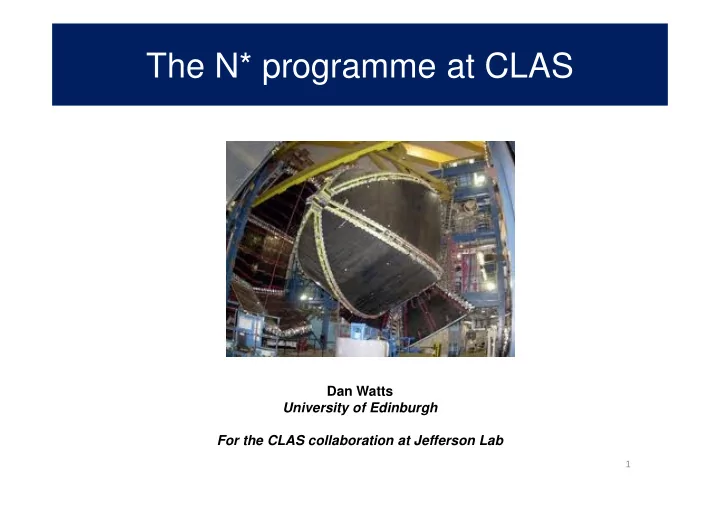

The N* programme at CLAS Dan Watts University of Edinburgh For the CLAS collaboration at Jefferson Lab 1
Outline Outline Outline � � General motivations General motivations � � Observables in meson Observables in meson photoproduction photoproduction � � Experimental details Experimental details � � Preliminary results for several Preliminary results for several polarization observables polarization observables � � Conclusions Conclusions 2
Motivation: nucleon excitation spectrum Motivation: Baryon resonances Motivation: Baryon resonances � � Masses, widths, and coupling Masses, widths, and coupling constants not well known for many constants not well known for many resonances resonances � Many models: relativised quark model, Goldstone-boson exchange, model, Goldstone-boson exchange, diquark and collective models, instanton-induced interactions, flux- tube models, holographic dual, lattice QCD… � Big Puzzle: Most models Big Puzzle: Most models predict more resonance states predict more resonance states than observed than observed Lattice QCD predictions Hadron spectrum collab. Arxiv:1104.5152 (2011)
Outline Outline Outline � � General motivations General motivations � � Observables in meson Observables in meson photoproduction photoproduction � � Experimental details Experimental details � � Preliminary results for several polarization Preliminary results for several polarization observables observables � � Conclusions Conclusions 4
Observables in pseudo scalar meson photoproduction ��������������� ������������ ������������� ���������� ������������������������� γ γ γ γ
The task ahead � Finding missing resonances and better establishing the properties of “known” resonances requires an extensive measurement programme � Requires measurement of a complete or close to complete set of observables over a wide kinematic range & wide range of final states � Such goals are finally coming within reach ! Such goals are finally coming within reach ! � � The CLAS facility will contribute a large fraction of the required high The CLAS facility will contribute a large fraction of the required high quality meson quality meson photoproduction photoproduction data data 6
Useful tools: Isospin decomposition � Differing isospin overlaps of N* and ∆ + for the π 0 p and π + n final states � The π 0 p and π + n final states can help distinguish between the ∆ and N* � + � + N* N* 0 π + = 3 = 1 − = 1 = 1 p : 2 / 3 I , I 1 / 3 I , I 3 3 2 2 2 2 + π + = 3 = 1 + = 1 = 1 n : 1 / 3 I , I 2 / 3 I , I 2 3 2 2 3 2 7
“Isospin filters” “Isospin filters” Useful tools: Isospin filtering � Resonance spectrum has many broad overlapping states � The η p , K + Λ and p ω systems have I=½ and act as isospin isospin filters filters to the resonance spectrum . γ p → π + n γ p → η p 8
Useful tools: Multipion final states � 64 observables, 8 reaction amplitudes � 28 independent relations related to magnitudes of reaction amplitudes � 21 independent relations related to phases of amplitudes � Results in 15 independent observables Good for discovering Good for discovering resonances that decay resonances that decay into other resonances! into other resonances! 9
Recommend
More recommend